An Information Architect may also be known as a User Experience Architect. They often report into a Head of User Experience or User Experience Lead.
Information Architect (IA) jobs
If you are looking for an Information Architect job or would like to find out how to become an Information Architect, what skills you need, and what salaries are on offer, you will find a complete guide below.
If you’re an employer looking to recruit for an Information Architect position, please see our product design and UX recruitment services page, and the full overview of our services to employers. If you need to hire and would like our services, contact us today.
What is an Information Architect?
The field of information architecture (IA) focuses on the organisation and structure of information within a system or environment. Information Architects play a crucial role in designing intuitive and user-friendly information spaces, such as websites, intranets, and software applications. They employ various techniques and methodologies to ensure that users can easily find and navigate through information, leading to improved user experiences.
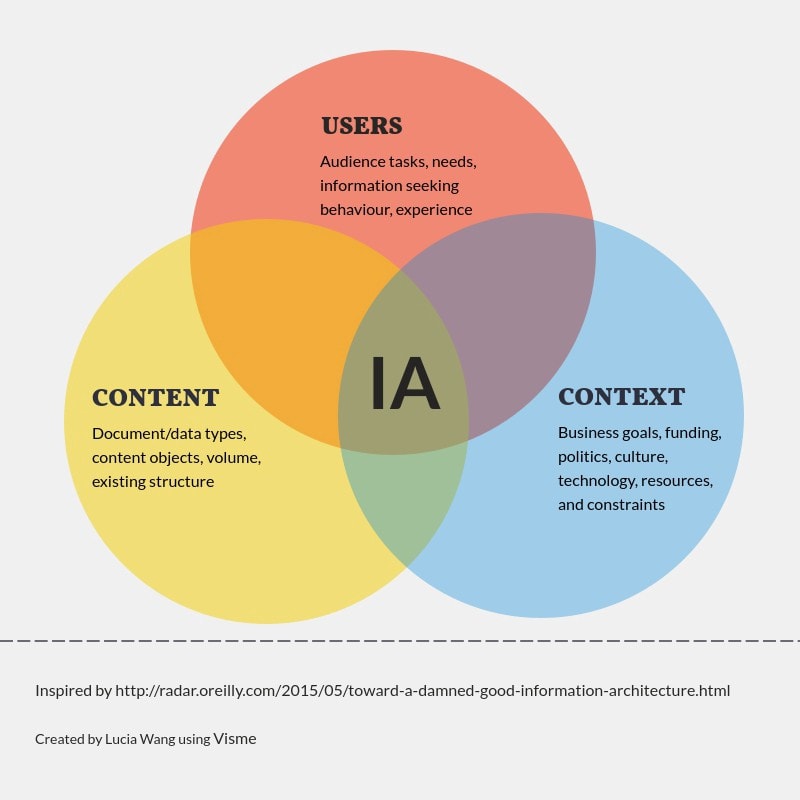
Why is IA important?
Information architecture is crucial to a business as it plays a vital role in shaping the organisation and accessibility of digital information, leading to improved user experiences, increased engagement, and measurable business benefits. Well-designed information architecture ensures intuitive navigation, efficient content retrieval, and seamless interactions, resulting in reduced bounce rates, increased page views, longer time on site, and improved conversion rates. By facilitating easy access to relevant information, information architecture fosters customer satisfaction, strengthens brand reputation, enhances user retention, and ultimately drives business growth and success.
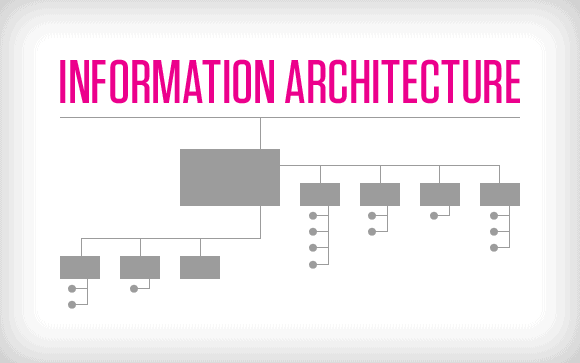
Information Architecture principles
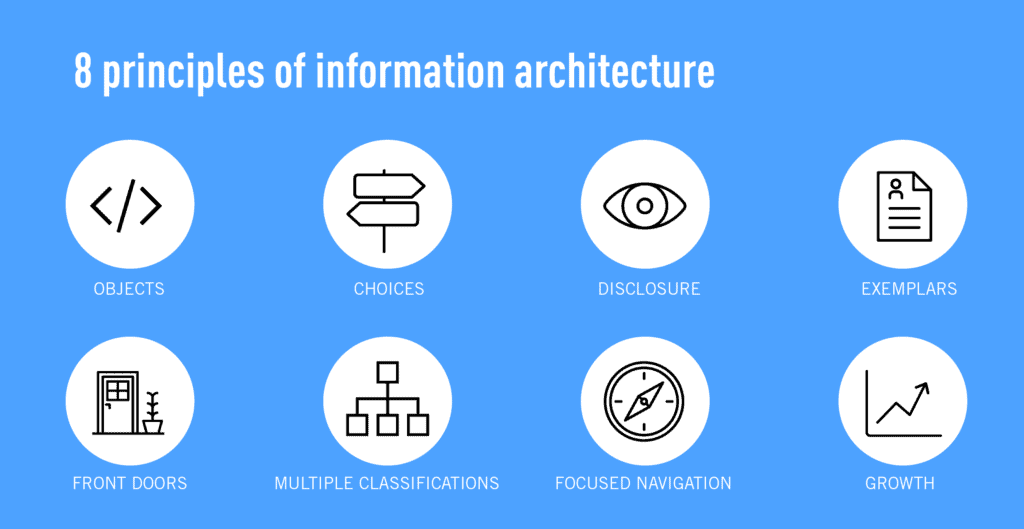
Information Architect responsibilities
Information Architects are responsible for creating the blueprint of an information system, ensuring that it meets the needs of both the users and the business. Their role involves:
Information organisation: analyse and understand the content and data that will be included in the system. They categorise and structure the information in a logical and meaningful way, considering factors such as hierarchy, relationships, and user requirements. This organisation enables users to find information quickly and efficiently.
Navigation design: effective navigation is crucial for users to move seamlessly through the information space. The role includes designing intuitive navigation systems, including menus, search functionality, and links, ensuring that users can easily locate and access the desired information. They focus on creating clear and consistent navigation paths to enhance user flow.
User research: conduct user research to gain insights into user needs, behaviours, and preferences. They employ various techniques such as interviews, surveys, and usability testing to understand user expectations and challenges. This research helps them make informed decisions during the design process and tailor the information architecture to meet user requirements.
Collaboration: work closely with stakeholders, such as designers, developers, content creators, and project managers. They collaborate to ensure that the information architecture aligns with the overall project goals and objectives. They act as advocates for users, representing their needs and preferences throughout the design and development process.
Documentation: Information Architects create documentation that outlines the information structure and navigation design of the system. These documents may include site maps, wireframes, flowcharts, and user personas. Documentation serves as a reference for stakeholders and provides a framework for the implementation of the information architecture.
How to become an Information Architect
Becoming an Information Architect typically involves a combination of education, experience and acquiring relevant skills. While the specific steps may vary depending on individual circumstances and preferences, here is a general outline of the process:
Obtain a relevant degree
Pursue a bachelor’s or master’s degree in a field related to information architecture, such as information science, library science, computer science, human-computer interaction, or user experience design. These programs provide a solid foundation in information organisation, usability and user-centred design principles.
Gain foundational knowledge
Familiarise yourself with the core concepts and principles of information architecture. Read books, research papers, and industry blogs to understand topics such as content organisation, information retrieval, taxonomies, metadata, user research, and information visualisation.
These resources should provide you with a solid foundation in information architecture principles, methods, and industry insights:
Book: “Information Architecture: For the Web and Beyond” by Louis Rosenfeld and Peter Morville. This seminal book provides a comprehensive introduction to information architecture principles and practices in the context of the web and beyond. Link to book
Website: Information Architecture Institute (IAI). The IAI is a non-profit organisation dedicated to advancing the practice and understanding of information architecture. They provide resources, articles, and a community for information architects. Link to website
Publication: Boxes and Arrows. Boxes and Arrows is an online publication that focuses on the practice, innovation, and discussion of information architecture, user experience design, and related disciplines. It features articles, case studies, and interviews with industry experts. Link to publication
Book: “Don’t Make Me Think” by Steve Krug. Although not solely focused on information architecture, this book is highly recommended for anyone involved in designing websites or digital products. It covers usability principles and provides practical advice on how to create intuitive and user-friendly interfaces. Link to book
Book: “The Elements of User Experience: User-Centred Design for the Web and Beyond” by Jesse James Garrett. This book provides an overview of the user-centred design process, including information architecture, and explores the relationships between different UX disciplines. Link to book
Publication: UX Booth. UX Booth is an online publication that covers various aspects of user experience design, including information architecture. It features articles, case studies, and resources that can help information architects stay up-to-date with industry trends and best practices. Link to publication
Book: “How to Make Sense of Any Mess” by Abby Covert. This practical guide provides a structured approach to information architecture, focusing on understanding, organising, and communicating complex information effectively. Link to book
Podcast: “UX Podcast” hosted by James Royal-Lawson and Per Axbom. While covering a broad range of UX topics, this podcast often explores information architecture-related themes, featuring interviews with industry experts and discussing real-world examples. Link to podcast
Develop technical skills
Acquire proficiency in relevant tools and technologies used in information architecture. This may include content management systems (CMS), wireframing and prototyping tools, information visualisation software, and project management tools. Learn how to use these tools effectively to create and manage information structures.
1. Content Management Systems (CMS): Understanding CMS platforms is crucial for Information Architects as they often work with structured content and need to design information structures within these systems. Learning CMS involves familiarising yourself with popular platforms such as WordPress, Drupal, or Sitecore, and understanding their features and capabilities. Online tutorials, documentation, and community forums provided by CMS vendors can be valuable resources for learning CMS skills. WordPress Codex, Drupal Documentation, Sitecore Developer Network
2. Wireframing and Prototyping Tools: Proficiency in wireframing and prototyping tools is essential for visually representing information structures and user interfaces. Tools like Sketch, Adobe XD, or Figma enable information architects to create interactive wireframes and prototypes. Learning these tools often involves a combination of online tutorials, video courses, and practice exercises. Resources like Udemy, LinkedIn Learning, and YouTube offer various courses and tutorials on these tools. Sketch, Adobe XD, Figma, Udemy, LinkedIn Learning
3. Information Visualisation: Information Architects should have a good understanding of information visualisation techniques to present complex information in a visually appealing and understandable manner. Learning information visualisation involves studying data visualisation principles, exploring visualisation libraries like D3.js or Tableau, and practicing creating effective visual representations of information. Online courses and books like “The Truthful Art” by Alberto Cairo and “Data Visualization with D3.js Cookbook” by Nick Qi Zhu can be helpful resources. D3.js, Tableau, “The Truthful Art” by Alberto Cairo, “Data Visualization with D3.js Cookbook” by Nick Qi Zhu
4. Taxonomy and Metadata Management: Knowledge of taxonomies, controlled vocabularies, and metadata is vital for structuring and organising information effectively. Information Architects should learn about taxonomy design principles, metadata standards (e.g., Dublin Core), and tools like PoolParty or Synaptica for taxonomy management. Resources like books, webinars, and conferences by industry experts and organisations like Taxonomy Boot Camp can provide valuable insights. PoolParty, Synaptica
5. SEO and Search Analytics: Understanding search engine optimisation (SEO) principles and search analytics helps Information Architects design information structures that are discoverable and user-friendly. Learning SEO involves staying updated on search engine algorithms, keyword research techniques, and SEO best practices. Online resources like Moz’s Beginner’s Guide to SEO and Google Analytics Academy can provide valuable insights into these topics. Moz’s Beginner’s Guide to SEO, Google Analytics Academy
6. User Research Methods: Information architects should be skilled in conducting user research to understand user needs and behaviours. Learning user research methods includes studying qualitative and quantitative research techniques, usability testing, and user interviewing. Books like “Just Enough Research” by Erika Hall and online courses like those offered by the Nielsen Norman Group can provide a solid foundation in user research. “Just Enough Research” by Erika Hall, Nielsen Norman Group
7. Information Architecture Evaluation: Proficiency in evaluating and testing information architectures is crucial for ensuring usability and findability. Learning evaluation methods involves understanding heuristic evaluation, card sorting, tree testing, and usability testing techniques. Resources like “Information Architecture: Blueprints for the Web” by Christina Wodtke and “Treejack” by Optimal Workshop can provide guidance on evaluation methods and tools. “Information Architecture: Blueprints for the Web” by Christina Wodtke, Treejack by Optimal Workshop
8. Data Modelling and Database Design: A solid understanding of data modelling and database design principles is beneficial for information architects working on projects involving complex data structures. Learning data modelling involves studying entity-relationship diagrams, database normalisation, and database design patterns. Online courses like those available on Coursera, such as “Database Management Essentials” by University of Colorado System, can help develop these skills. Coursera, “Database Management Essentials” by University of Colorado System
9. Project Management Tools: Information architects often collaborate with multidisciplinary teams, making project management skills important for effective communication and coordination. Learning project management tools like Jira, Asana, or Trello involves exploring their features, understanding agile methodologies, and practicing project planning and tracking. The official documentation and tutorials provided by these tools can be valuable resources for learning. Jira, Asana, Trello
10. Accessibility Standards: Information Architects should be knowledgeable about web accessibility standards to ensure that information structures are inclusive and usable for everyone. Learning accessibility involves understanding WCAG (Web Content Accessibility Guidelines) principles, ARIA (Accessible Rich Internet Applications) specifications, and conducting accessibility audits. Resources like the WCAG documentation and the “Accessibility Handbook” by Katie Cunningham can provide guidance on accessibility standards. WCAG, “Accessibility Handbook” by Katie Cunningham
By developing these technical skills, information architects can effectively design and manage information structures to enhance user experiences. Utilise the mentioned resources to enhance your skills and stay up-to-date with the latest industry trends.
Gain practical experience
Seek opportunities to apply your knowledge in real-world scenarios. Look for internships, part-time jobs, or volunteer positions in organisations where you can work on information architecture projects. This hands-on experience will help you develop practical skills, understand user needs, and learn how to collaborate with multidisciplinary teams.
View our jobs page for available Information Architecture roles or upload your CV with us today.
Build a portfolio
Create a portfolio that showcases your information architecture projects. Include case studies, wireframes, prototypes, and any other artefacts that demonstrate your skills and problem-solving abilities. Your portfolio should highlight your approach to information organisation, usability, and user experience.
Network and collaborate
Engage with professionals in the field of information architecture. Attend industry events, conferences, and meetups to connect with practitioners and learn from their experiences. Join online communities, forums, and social media groups to participate in discussions and stay updated on industry trends.
Here are six networking events for Information Architects in the UK:
UXPA UK Conference: The UXPA UK Conference is a leading event for user experience professionals, including information architects. It provides an excellent opportunity to network with industry experts, attend informative sessions, and participate in workshops.
London IA: London IA is a community-driven group that organises regular meetups and events focused on information architecture and related topics. These events gather information architects, UX designers, content strategists, and other professionals to share knowledge and network.
Content Strategy London: Content Strategy London is a community that brings together professionals interested in content strategy, which often intersects with information architecture. Their events feature talks, panel discussions, and networking opportunities.
Design Research London: Design Research London is a meetup group that explores various aspects of design research, including user research and information architecture. Attending their events allows you to connect with researchers, designers, and information architects who are passionate about user-centred design.
London Web Standards: London Web Standards is a community that hosts regular events on various web-related topics, including information architecture. These events bring together professionals from different disciplines, fostering cross-disciplinary discussions and networking opportunities.
Information Architecture Manchester: Information Architecture Manchester is a meetup group that organises events focused specifically on information architecture. These events provide a platform to connect with fellow information architects, share experiences, and discuss current trends and challenges in the field.
Attending these networking events allows you to meet like-minded professionals, exchange ideas, and expand your professional network within the information architecture community in the UK.
Continue learning
Information architecture is a dynamic field, and it’s essential to stay updated with the latest trends, methodologies, and tools. Participate in professional development activities, take online courses, and pursue certifications to enhance your knowledge and demonstrate your commitment to ongoing learning.
While there aren’t specific certifications exclusively dedicated to Information Architecture (IA) in the UK, there are several related certifications and credentials that can enhance your credibility and demonstrate your expertise in IA and user experience design. Here are five notable certifications:
Certified Professional in User Experience (CPUX): CPUX is an internationally recognised certification offered by the International Usability and User Experience Qualification Board (UXQB). It covers various aspects of user-centred design, including information architecture. CPUX certification demonstrates your knowledge and skills in IA and UX design.
Certified User Experience Professional (CUXP): CUXP is a certification offered by the British Computer Society (BCS). It validates your proficiency in user experience design, including information architecture. CUXP certification showcases your competence in IA and UX methodologies.
Certified Information Professional (CIP): The Certified Information Professional designation is offered by AIIM (Association for Intelligent Information Management) and signifies your expertise in information management and governance, which often includes information architecture. CIP certification demonstrates your knowledge of IA principles in the context of broader information management practices.
Certified Usability Analyst (CUA): The Certified Usability Analyst certification, offered by Human Factors International (HFI), covers a range of usability and user-centred design topics, including information architecture. CUA certification validates your IA skills and knowledge in the context of usability and user experience.
Certified Customer Experience Professional (CCXP): The Certified Customer Experience Professional certification, administered by the Customer Experience Professionals Association (CXPA), focuses on various aspects of customer experience, including information architecture. CCXP certification showcases your understanding of IA and its role in delivering exceptional customer experiences.
While these certifications may not be exclusively focused on information architecture, they encompass relevant skills and knowledge within the broader field of user experience and information management. They can help you establish credibility, expand your professional network, and demonstrate your commitment to continuous learning and professional development. Be sure to review the specific requirements, study materials, and examination processes associated with each certification to determine which one aligns best with your career goals.
Seek employment opportunities
Look for job openings or freelance projects that specifically require information architecture skills. Update your resume and tailor it to highlight your relevant experience and skills. Prepare for interviews by familiarising yourself with common interview questions and showcasing your problem-solving abilities and understanding of user-centred design.
Remember that the path to becoming an information architect is not strictly linear, and it may involve exploring related roles such as user experience (UX) design, content strategy, or interaction design. Building a strong foundation in these areas can also contribute to your expertise in information architecture.
Information Architect career path
Here is a common career path with relevant job titles that professionals often encounter while progressing in this field:
Entry-level UX Designer or UX Researcher: Many Information Architects start their careers as entry-level UX Designers or UX Researchers. In these roles, they gain foundational knowledge of user-centred design principles, conduct user research, and contribute to the overall user experience design process.
UX Designer or Interaction Designer: After gaining experience as an entry-level professional, individuals may move into roles such as UX Designer or Interaction Designer. Here, they focus on designing and creating intuitive and user-friendly interfaces and experiences, including information architecture components.
Information Architect: As professionals gain more experience and expertise in user experience design, they can transition into dedicated Information Architect roles. As Information Architects, they specialise in designing and organising complex information structures, creating taxonomies, developing navigation systems, and ensuring findability and usability of information.
Senior Information Architect: With several years of experience, professionals may progress to senior-level positions. Senior Information Architects take on more complex projects, lead information architecture initiatives, mentor junior team members, and provide strategic guidance in information organisation and design.
UX Manager or UX Director: Some may choose to pursue management or leadership positions in their career path. They can move into roles such as UX Manager or UX Director, where they oversee and guide UX teams, provide direction on information architecture strategies, and collaborate with stakeholders to shape the user experience vision.
Information Architecture Consultant or Specialist: Experienced Information Architects may decide to become independent consultants or specialise in specific areas of information architecture, such as enterprise information architecture, e-commerce IA, or IA for specific industries.
Information Architect salary
In 2024, an annual salary of £60,000 to £80,000 can be expected for an Information Architect.
Information Architect job description
A typical Information Architect job description will read something like the below:
We are seeking an experienced and talented Information Architect to join our fast-growing scale-up tech business. As an Information Architect, you will play a crucial role in designing and organising information structures to enhance the usability, findability, and overall user experience of our digital products. You will work closely with cross-functional teams, including UX designers, developers, and product managers, to create intuitive and user-centred information architectures.
Responsibilities:
- Collaborate with cross-functional teams to understand business goals, user needs, and project requirements.
- Conduct user research, including user interviews and usability testing, to gain insights into user behaviors and preferences.
- Develop information architecture strategies, frameworks, and taxonomies that align with business objectives and user requirements.
- Create wireframes, prototypes, and interactive models to visualise and communicate information structures and navigation systems.
- Ensure consistent information organisation and labeling across digital products, maintaining alignment with industry best practices and usability standards.
- Collaborate with UX designers to optimise the user interface and interactions, ensuring a seamless and intuitive user experience.
- Conduct usability assessments and heuristic evaluations to identify areas for improvement and provide recommendations for enhancing information architecture
- Stay updated with industry trends, emerging technologies, and best practices related to information architecture and user experience design.
- Act as a subject matter expert in information architecture, providing guidance and support to team members and stakeholders.
Requirements
- Bachelor’s or Master’s degree in a relevant field, such as Information Science, User Experience Design, or Human-Computer Interaction.
- Proven experience working as an Information Architect, UX Designer, or similar role in a fast-paced tech environment.
- Strong understanding of information architecture principles, methodologies, and best practices.
- Proficiency in wireframing and prototyping tools (e.g., Sketch, Adobe XD, or Figma) to visualise information structures and navigation systems.
- Familiarity with user research techniques and usability testing methodologies.
Knowledge of content management systems (CMS) and their impact on information architecture. - Excellent analytical and problem-solving skills, with a keen eye for detail and ability to balance user needs with business goals.
- Strong communication and collaboration skills to work effectively with cross-functional teams and stakeholders.
- Ability to adapt to a fast-paced and dynamic work environment, managing multiple projects and priorities.
Information Architecture job hunting
Intelligent People: As Product Design and UX recruitment experts, we have a broad range of IA jobs suitable for any level. View our jobs page.
LinkedIn: LinkedIn is a professional networking platform that hosts a wide range of job opportunities. You can search for Information Architecture jobs in the UK by using relevant keywords and filters. LinkedIn Jobs
Indeed: Indeed is a popular job search engine that aggregates job postings from various sources. You can search for Information Architecture jobs in the UK by specifying your location and desired job title. Indeed UK
CWJobs: CWJobs is a leading job board specifically focused on IT and tech-related roles. It features a dedicated section for UX and Information Architecture jobs in the UK. CWJobs
UXPA UK Job Board: The UXPA UK Job Board is a platform dedicated to UX and related roles, including Information Architecture. It features job postings from various organisations looking for professionals in the field. UXPA UK Job Board
Design Week Jobs: Design Week Jobs is a popular platform for design-related job opportunities, including Information Architecture roles. It showcases vacancies from various design-focused companies in the UK. Design Week Jobs
Glassdoor: Glassdoor is a platform that not only provides job listings but also offers insights into company reviews, salaries, and interview experiences. You can search for Information Architecture jobs in the UK and gather valuable information about potential employers. Glassdoor UK
Information Architecture process
The process of information architecture involves several key steps to design and structure information in a meaningful and user-friendly way. Here is a general overview of the information architecture process:
Research and analysis
The process begins with gathering relevant information about the project, including business goals, user requirements, and content inventory. Conduct user research, such as interviews, surveys, and usability testing, to gain insights into user needs, behaviors, and expectations.
Define scope and objectives
Clearly define the scope of the project and establish the objectives for the information architecture. Identify key stakeholders and gather their input to ensure alignment and understanding of project goals.
User personas and scenarios
Develop user personas to represent different user types, their goals, and needs. Create user scenarios to understand how users interact with the system and the information they seek.
Card sorting and content grouping
Conduct card sorting exercises to involve users in organising and categorising content. Analyse the results to identify common patterns and group related content together logically.
Information structure design
Based on the insights gained from user research and card sorting, create an initial information structure. Design the navigation system, including the global and local navigation elements, to enable users to find information easily.
Wireframing and prototyping
Create wireframes and prototypes to visualise the information architecture. Use tools like Axure RP, Sketch, or Adobe XD to create interactive and low-fidelity representations of the information structure and navigation.
Iterative design and testing
Continuously refine the information architecture through an iterative process. Conduct usability testing and gather feedback to identify areas of improvement, validate the effectiveness of the structure, and ensure it meets user needs.
Metadata and tagging
Define metadata and tagging strategies to enhance searchability and findability. Implement metadata schemas and guidelines to ensure consistent and meaningful labelling of content.
Collaboration and documentation
Collaborate with UX designers, developers, and content creators to ensure the information architecture aligns with the overall user experience. Document the information architecture, including site maps, user flows, and content models, to provide guidance and reference for the project team.
Maintenance and evaluation
Continuously monitor and evaluate the information architecture’s performance. Gather user feedback, analyse site analytics, and conduct regular content audits to identify areas for optimisation and ensure the structure remains aligned with evolving user needs.
What soft skills are employers looking for?
Effective communication: Strong communication skills are vital for an Information Architect to clearly articulate complex information structures and collaborate with cross-functional teams, ensuring alignment and understanding throughout the design process.
Critical thinking: The ability to think critically enables an Information Architect to analyse user needs, evaluate design options, and make informed decisions when structuring and organising information, ensuring optimal usability and findability.
Empathy: Empathy is crucial for an Information Architect to understand the perspectives and behaviours of users, enabling them to create information architectures that align with user needs and enhance the overall user experience.
Attention to detail: Attention to detail is important in information architecture to ensure accurate labelling, consistent organisation, and seamless navigation, contributing to a cohesive and user-friendly digital experience.
Collaboration: The ability to collaborate effectively with UX designers, developers, and stakeholders is essential for an Information Architect to ensure that information architecture aligns with the overall design vision, technical feasibility, and business goals.
Adaptability: Information Architects should be adaptable to evolving project requirements, technological advancements, and changing user needs, enabling them to quickly pivot and adjust information architectures to meet new challenges and opportunities.
These soft skills complement the technical expertise of an Information Architect and enable them to navigate the dynamic landscape of user experience design, ensuring that information architectures meet user needs, business objectives, and technological constraints.
Information Architecture models
These models provide frameworks for structuring and organising information in a way that enhances usability, findability, and overall user experience. Information Architects often select or combine these models based on the specific needs and context of their projects. Understanding these models helps in designing effective information architectures that meet user needs and support business objectives.
Hierarchical model: The hierarchical model represents information structures in a hierarchical tree-like format, with parent and child relationships. It is based on organising information into nested categories or levels, allowing users to navigate through a clear and structured hierarchy.
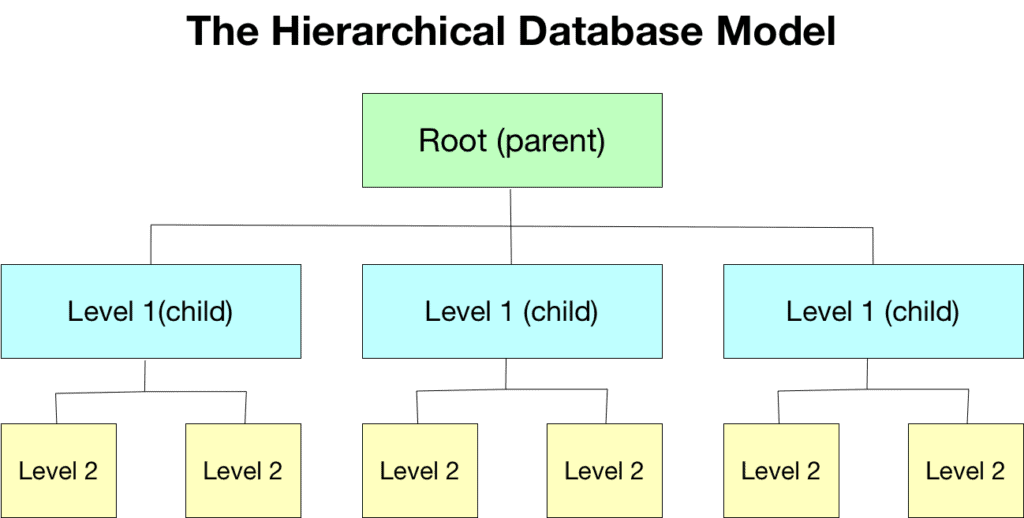
Network Model: The network model represents information as a network of interconnected nodes, allowing for non-linear relationships between pieces of information. This model is suitable for complex systems with multiple connections and dependencies.

Faceted Model: The faceted model organises information based on multiple facets or attributes. It allows users to filter and navigate through information using different facets simultaneously, providing a flexible and customisable browsing experience.
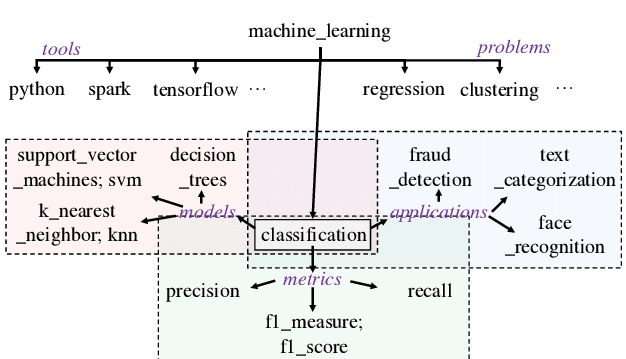
Other models include:
Semantic Model: The semantic model focuses on the meaning and relationships between information elements. It employs semantic structures, such as ontologies and taxonomies, to represent concepts, categories, and their relationships, enabling more sophisticated information retrieval and knowledge discovery.
Object-Oriented Model: The object-oriented model organises information around objects or entities with properties and relationships. It represents information as discrete objects that can be manipulated and interacted with, supporting more dynamic and interactive user experiences.
Hybrid Models: Hybrid models combine elements from different IA models to meet specific needs or to address complex information architectures. These models may incorporate elements of hierarchical, network, faceted, semantic, or object-oriented models, customised to the unique requirements of a particular system or domain.
What tools to Information Architects use?
These tools provide Information Architects in the UK with the means to effectively design, communicate, and validate information architectures. Each tool offers its unique features and capabilities, so it’s important to assess your specific requirements and choose the tool that best suits your needs.
Axure RP: Axure RP is a powerful prototyping tool that allows Information Architects to create interactive wireframes and prototypes to visualise and test information structures. Axure RP
Sketch: Sketch is a popular design tool that Information Architects use for creating wireframes and visual designs. It offers a range of features and plugins specifically tailored to UX and UI design. Sketch
Adobe XD: Adobe XD is a comprehensive design and prototyping tool used by Information Architects to create interactive wireframes, user flows, and high-fidelity prototypes. Adobe XD
Lucidchart: Lucidchart is a collaborative diagramming tool that Information Architects use to create IA artifacts such as site maps, flowcharts, and mind maps. It enables effective communication and visualisation of information structures. Lucidchart
Miro: Miro is a digital whiteboard platform that Information Architects often utilise for collaborative workshops, ideation sessions, and collaborative diagramming. It facilitates remote collaboration and information visualisation. Miro
Optimal Workshop: Optimal Workshop is a suite of user research and IA testing tools. Information Architects can leverage tools like Treejack for IA validation, OptimalSort for card sorting, and Chalkmark for usability testing. Optimal Workshop
MindManager: MindManager is a mind mapping tool that Information Architects use to brainstorm, organise ideas, and create visual representations of information structures. It helps in visualising relationships and connections within complex systems. MindManager
InVision: InVision is a prototyping and collaboration platform used by Information Architects to create interactive prototypes and gather feedback from stakeholders and users. It streamlines the iterative design process. InVision
Information Architect FAQs
- What does an Information Architect do?
- An Information Architect, is responsible for creating and maintaining all web based sites and applications, translating user behaviour into habits and structures and organising content in a way that anticipates the end users requirements.
- Is being an Information Architect a good career?
- Yes being an Information Architect is considered a good career, earning a salary of £60,000 to £80,000 within the UK.



